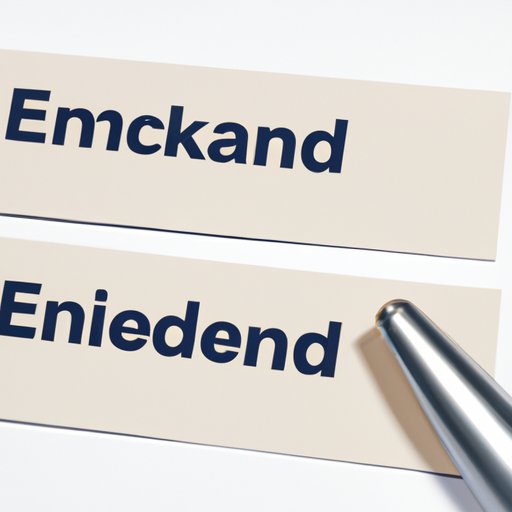
Introduction
Endorsing a check may seem like a simple task, but it’s important to do it correctly. Endorsing a check is the process of signing over ownership of it to someone else. Whether you’re depositing a check or passing it on to someone else, it’s essential to endorse it correctly. In this article, we’ll explore everything you need to know about endorsing checks, including the different types of endorsements and how to avoid common mistakes.
The Step-By-Step Guide to Endorsing a Check
The first step in endorsing a check is to sign your name on the back of it. This is known as a blank endorsement and can be used when you’re simply depositing the check into your bank account. However, if you’re giving the check to someone else, you’ll need to use a different type of endorsement to ensure that the check goes to the right person.
The next step is to write “For Deposit Only” beneath your signature if you’re depositing the check into your own account. This restricts the check to only be deposited, and not cashed. If you’re giving the check to someone else, you can use a restrictive endorsement by writing “For [Payee’s Name]” underneath your signature. This endorsement restricts the check’s use only to the payee you specify.

Everything You Need to Know About Endorsing Checks
Endorsing a check is more than just signing your name on the back of it. There are different types of endorsements you can use, depending on the situation. The three main types of endorsements are blank, restrictive, and special.
A blank endorsement is where you sign the back of the check and nothing else. This is the most basic type of endorsement and allows anyone to cash or deposit the check. A restrictive endorsement limits the use of the check to a specific person or purpose, while a special endorsement requires the payee to sign their name on the back before cashing or depositing the check.
The Types of Endorsements: How to Choose the Right One
Choosing the right type of endorsement depends on your situation. When depositing a check into your account, a blank endorsement is usually sufficient. However, if you’re giving a check to someone else, you may want to use a restrictive endorsement to ensure that it’s used only for the intended purpose.
If you’re endorsing a check for a business, a special endorsement may be necessary to ensure that the funds are deposited into the correct account. Similarly, if the check is written to more than one person, a special endorsement may be required to ensure that all parties have endorsed the check.
Endorsing Checks in the Digital Age
Technology has changed the way we endorse checks. In some cases, you may be able to endorse a check digitally or through a mobile app. If you’re depositing a check using a mobile app, you may need to write “For Mobile Deposit Only” underneath your signature. This ensures that the check is not deposited via any other method.
Endorsing Checks for Small Business Owners: Tips and Tricks
Endorsing checks as a small business owner can be tricky. To make the process more efficient, consider using a stamp or pre-printed endorsement that includes your business name and account number. This can save time and ensure that checks are deposited correctly. Additionally, be sure to keep accurate records of all checks that are deposited and the endorsements used.
Common Mistakes to Avoid When Endorsing a Check
One of the most common mistakes people make when endorsing checks is forgetting to sign the back. However, other mistakes can also cause problems. Using the wrong type of endorsement or failing to include important information on the back of the check can result in the check being returned or delayed. Always double-check your endorsement before submitting a check for deposit or cashing.
Endorsing Checks for Beginners: A Comprehensive Guide
To endorse a check, start by signing your name on the back in the designated area. If you’re depositing the check into your account, write “For Deposit Only” beneath your signature. If you’re giving the check to someone else, write “For [Payee’s Name]” underneath your signature to restrict the use of the check. When endorsing a check for a business, consider using a stamp or pre-printed endorsement that includes your business name and account number. Always double-check your endorsement to ensure that it’s correct before submitting the check for deposit or cashing.
Conclusion
In conclusion, endorsing checks is an essential task that must be done correctly to avoid delays or problems. Understanding the different types of endorsements and how to use them can make the process smoother and more efficient. By using the tips and strategies discussed in this article, you can endorse checks with confidence and avoid common mistakes.





